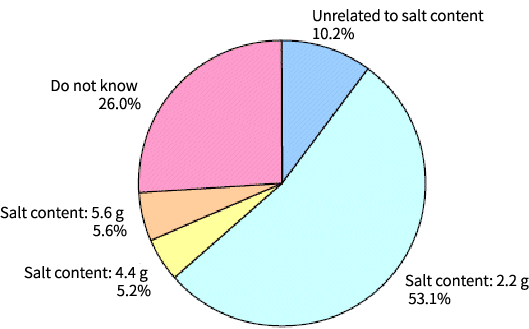Saltiness influences how good a dish tastes. This "salt," also known as sodium chloride, is made of sodium and chlorine. Sodium chloride equivalent is calculated by converting the sodium content in a food product to the amount of sodium chloride using the following formula.
Sodium (mg) × 2.54 ÷ 1,000 = sodium chloride equivalent (g)
In recent years, the sodium content is being displayed on food's nutritional information labels, rather than salt content. This is because, from a medical or nutritional standpoint, sodium (Na) has been shown to have more of an effect on the human body than sodium chloride (NaCl). Besides sodium chloride, sodium is also found in monosodium glutamate (the umami component in 'kombu' kelp), sodium ascorbate (vitamin C), and other sources. Labels list sodium rather than sodium chloride internationally, as well. To calculate the sodium chloride equivalent, the sodium content is multiplied by 2.54, but even when using the result of this calculation, it is important to understand that it is merely a value calculated with the assumption that all of the sodium content is contained within sodium chloride. Therefore the actual sodium chloride content is lower than the sodium chloride equivalent (calculated value).
Sodium exists within food in many forms, such as sodium bicarbonate, monosodium glutamate, and sodium ascorbate, but most of it comes from salt (sodium chloride). Sodium regulates the interior and exterior osmotic pressure of all of the cells within the human body, making it an indispensable mineral for sustaining life. It is involved in almost all of the body's functions, from the nervous system to hormone regulation to the kidneys. Depending on eating habits, however, there are people whose salt intake greatly exceeds the necessary amount. Since this is one of the leading causes of high blood pressure, limiting salt intake is recommended (salt intake of less than 10 g a day for adults age 15–69).
Source: MEGMILK SNOW BRAND home page
On April 27, 2009, Novartis released the results of a survey of men and women 40 and older titled "Attitude Survey on Salt Intake." According to the results of the survey, only 5.6% of respondents had a correct understanding of the relationship between sodium content and salt content in nutritional information. The majority of respondents believed that sodium content and salt content are the same, an indication that more education on salt is needed (press release).
This survey was conducted over the internet from April 14 to 15, 2009, and there were 412 valid responses. There were 256 male respondents and 156 female respondents, and the ages of respondents were not released.
Recently there are more instances of the sodium chloride equivalent being included in nutritional information, but sodium does not directly correspond to salt content. The sodium chloride equivalent is correctly calculated using the following formula:
Sodium (mg) × 2.54 ÷ 1,000 = Salt content (g).
Sodium content is sometimes expressed in grams. In these cases, use the formula "Sodium (g) × 2.54 = Salt content (g)." For example, an item with 1,000 mg of sodium would have a sodium chloride equivalent of 2.54 g.
When respondents were asked what the corresponding salt content is when nutritional information lists "sodium 2.2 g," only 5.6% were able to choose the correct response, "5.6 g" (2.2 × 2.54 = 5.588).
Source: Novartis home page

More than half of the participants thought "sodium content = salt content," but as previously mentioned, (when measured in grams) the correct method is to multiply the sodium content by 2.54. With an incorrect understanding, the salt content will be underestimated.
Although the amount can differ depending on age, occupation, or lifestyle, the target daily salt intake for an adult male is less than 10 g. Overconsumption of salt can cause various illnesses such as high blood pressure. This is of course true for the target demographic of the survey (people age 40 and older), but the situation is the same for people below the age of 40 (even young people should not have a high salt intake). Calculating using the 2.54 formula reveals that many processed foods such as ready-to-eat meals have a surprisingly high salt content. Just knowing the 2.54 formula may change how people view the foods around them.
What does salt do in the body?
Salt is made up of sodium, which is necessary to sustain life, and chloride. Sodium plays important roles such as adjusting the amount of moisture in the body to appropriate levels and making sure that nerves and muscle move normally. Meanwhile, chlorine is a component in gastric juice and other bodily fluids.
Salt is present in almost all foods, so with a normal lifestyle there is no need to worry about a salt deficiency. When perspiring during physical activity or when experiencing vomiting or diarrhea, however, a large amount of sodium is lost, so it must be adequately replenished.
Excessive intake of salt is usually more of an issue. Diets with too much salt intake can cause various lifestyle-related diseases such as high blood pressure and stomach cancer.
According to a Japanese national survey of health and nutrition, the average salt intake in 2004 for a Japanese person was 10.7 g/day. The amount of salt intake necessary for survival for an adult, however, is only 1.5 g/day. Despite this, over half of adults consume more than 10 g of salt in a day. Rapidly lowering salt intake can cause problems like loss of appetite, but we all need to adjust to low-salt flavors and to reduce our salt intake. First adults must aim for the dietary reference intake's daily target sodium chloride equivalent (10 g or less for men, 8 g or less for women). Then we should do what we can to aim for the guidelines for prevention and treatment of high blood pressure given by the WHO and the International Society of Hypertension, less than 6 g a day.

